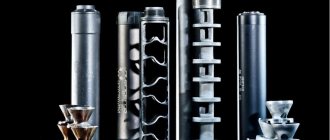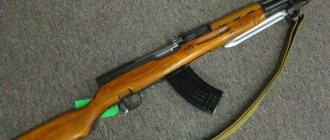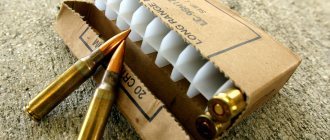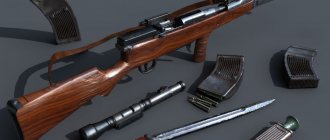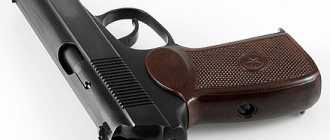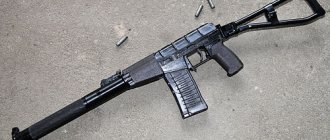| BS-1 (RGA-86) | |
| Type | underbarrel grenade launcher |
| A country | USSR USSR Russia Russia |
| Service history | |
| In service | USSR USSR Russia Russia |
| Production history | |
| Constructor | TsNIITochmash |
| Designed by | in the mid 1960s |
| Manufacturer | Central Research Institute of Precision Engineering |
| Characteristics | |
| Weight, kg | 1,7 |
| Cartridge | 30 mm VOG-T grenades |
| Caliber, mm | 30 |
| Work principles | separate loading |
| Initial bullet speed, m/s | 105 |
| Sighting range, m | 100-150 |
| Maximum range, m | 300 |
BS-1
(
RGA-86
) - a silent 30 mm under-barrel grenade launcher, was developed in the mid-1960s at TsNIITochmash for use in the silent grenade launcher system "Silence", where it was installed on the AKMS assault rifle that was in service with special forces. Since about the beginning of the 1980s, the BS-1M modification as part of the 6S1 “Canary” silent grenade launcher system was installed on the AKS-74UB assault rifle with a PBS-4 silencer.
Design
The BS-1 (RGA-86) silent under-barrel grenade launcher is a separate-loading weapon, in which the fired grenade is loaded into the barrel from the muzzle, and expelling (propelling) charges are fed into the breech of the barrel. At the moment of firing, the powder gases of the blank cartridge push forward the piston located at the rear of the barrel, accelerating the piston and grenade to a speed of over 100 m/s (up to 175 m/s for BS-1M). After the grenade leaves the barrel, the piston stops in the barrel, locking the high-pressure powder gases in a closed volume. After they cool down and the pressure drops to a safe level, it is possible to reload the grenade launcher, that is, load a new grenade into the barrel (in this case the piston settles back), eject the spent cartridge case and chamber a new expelling cartridge. The weapon is reloaded with cartridges from a detachable box magazine (capacity of 8 cartridges for BS-1 or 10 for BS-1M), located in the handle of the grenade launcher, using a longitudinally sliding rifle-type rotary bolt. For firing, the grenade launcher has a trigger and a manual safety catch. Two types of grenades are used: combat armor-piercing incendiary grenades (designation VOG-T) and training grenades with an inert warhead. In both cases, the stabilization of the grenade in flight is carried out by its rotation, for which purpose the grenade body has ready-made protrusions for following the rifling in the grenade launcher barrel. For aiming when firing from a grenade launcher, a special folding sight is installed on the rear sight block of the machine gun, used together with the standard front sight of the machine gun. To install a grenade launcher on an assault rifle, special mounts are used, while the early version (for AKMS) and the later version (for AKS-74UB) have different bracket systems and are incompatible in terms of seats.
Rifle silence
The PBS-1 silent firing device is screwed onto the threaded seat of the muzzle of the machine gun barrel instead of a compensator. The device is a cylindrical chamber divided into compartments by steel washers. The washers are fastened with three steel rods. There are holes in the center of the washers for the free passage of bullets. In front of the first compartment from the muzzle of the machine gun barrel there is a solid rubber washer 18-20 mm thick, which initially (newly installed) had no holes. In front of the washer there is an additional chamber for the transfer of powder gases with four holes around the circumference, opening into an expansion chamber at the base of the PBS, which also has four holes around the circumference of the body.
Excerpt characterizing BS-1
“Those people who sacrificed everything for him,” the princess picked up, trying to get up again, but the prince did not let her in, “which he never knew how to appreciate.” No, mon cousin,” she added with a sigh, “I will remember that in this world one cannot expect a reward, that in this world there is neither honor nor justice.” In this world you have to be cunning and evil. - Well, voyons, [listen,] calm down; I know your beautiful heart. - No, I have an evil heart. “I know your heart,” the prince repeated, “I value your friendship and would like you to have the same opinion of me.” Calm down and parlons raison, [let's talk properly] while there is time - maybe a day, maybe an hour; tell me everything you know about the will, and, most importantly, where it is: you must know. We will now take it and show it to the count. He probably already forgot about it and wants to destroy it. You understand that my only desire is to sacredly fulfill his will; I just came here then. I'm only here to help him and you. – Now I understand everything. I know whose intrigue it is. “I know,” said the princess. - That’s not the point, my soul. - This is your protegee, [favorite,] your dear princess Drubetskaya, Anna Mikhailovna, whom I would not want to have as a maid, this vile, disgusting woman. – Ne perdons point de temps. [Let's not waste time.] - Ax, don't talk! Last winter she infiltrated here and said such nasty things, such nasty things to the Count about all of us, especially Sophie - I cannot repeat it - that the Count became ill and did not want to see us for two weeks. At this time, I know that he wrote this vile, vile paper; but I thought that this paper meant nothing. – Nous y voila, [That’s the point.] why didn’t you tell me anything before? – In the mosaic briefcase that he keeps under his pillow. “Now I know,” said the princess without answering. “Yes, if there is a sin behind me, a great sin, then it is hatred of this scoundrel,” the princess almost shouted, completely changed. - And why is she rubbing herself in here? But I will tell her everything, everything. The time will come! While such conversations took place in the reception room and in the princess's rooms, the carriage with Pierre (who was sent for) and with Anna Mikhailovna (who found it necessary to go with him) drove into the courtyard of Count Bezukhy. When the wheels of the carriage sounded softly on the straw spread under the windows, Anna Mikhailovna, turning to her companion with comforting words, was convinced that he was sleeping in the corner of the carriage, and woke him up. Having woken up, Pierre followed Anna Mikhailovna out of the carriage and then only thought about the meeting with his dying father that awaited him. He noticed that they drove up not to the front entrance, but to the back entrance. While he was getting off the step, two people in bourgeois clothes hurriedly ran away from the entrance into the shadow of the wall. Pausing, Pierre saw several more similar people in the shadows of the house on both sides. But neither Anna Mikhailovna, nor the footman, nor the coachman, who could not help but see these people, paid no attention to them. Therefore, this is so necessary, Pierre decided to himself and followed Anna Mikhailovna. Anna Mikhailovna walked with hasty steps up the dimly lit narrow stone staircase, calling Pierre, who was lagging behind her, who, although he did not understand why he had to go to the count at all, and even less why he had to go up the back stairs, but , judging by the confidence and haste of Anna Mikhailovna, he decided to himself that this was necessary. Halfway up the stairs, they were almost knocked down by some people with buckets, who, clattering with their boots, ran towards them. These people pressed against the wall to let Pierre and Anna Mikhailovna through, and did not show the slightest surprise at the sight of them.
Rifle silence
The PBS-1 device is screwed onto the threaded seat of the muzzle of the machine gun barrel instead of a compensator. The device is a cylindrical chamber divided into compartments by steel washers. The washers are fastened with three steel rods. Holes are made in the center of the washers for free passage of zeros. In front of the first compartment from the muzzle of the machine gun barrel there is a solid rubber washer, which initially (newly installed) had no holes. In front of the washer there is an additional chamber for the transfer of powder gases with four holes around the circumference, opening into an expansion chamber at the base of the PBS, which also has four holes around the circumference of the body.
Silent rifle-grenade launcher system "Silence"
With the advent of understanding that the machine gun/grenade launcher complex shows quite high efficiency in combat, in addition to the creation of ordinary complexes, the question arose of creating a silent rifle-grenade launcher complex. Of course, no one set the task of creating silent grenades, but muffling the sound of the grenade itself was quite possible, and most importantly, in demand. One of the first rifle systems whose operation became almost silent was the “Silence” rifle-grenade launcher complex. It was based on an AKMS assault rifle with a PBS-1 silent firing device and a BS-1 grenade launcher. If the machine gun part is of no interest (there is more than enough information on the operating principle of the AKMS and what kind of weapon it is in general), then the grenade launcher part of the complex is unknown to most.
Rifle silence
The operating principle of the automation is a gas outlet. Locking is carried out by turning the bolt cylinder during the forward movement of the bolt frame - with locking on six lugs. The trigger mechanism provides both single shots and burst fire. It should be noted that conducting automatic fire through a silencer, regardless of its design, always negatively affects the quality of suppression. The powder gases do not have time to dissipate and cool, and the pressure does not have time to drop. The VSS rifle has an expansion-type muffler integrated into the design with annular diaphragm elements that reflect shock waves of powder gases. The barrel has several holes to relieve pressure into the rear cavity of the muffler (which distinguishes the integrated muffler from a conventional one). The silencer can be separated for cleaning and storage, but shooting without it is prohibited. Silencing the sound of a shot is based on the integrating principle. When a bullet passes past many holes in the walls of the barrel, powder gases penetrate through them into the expansion chamber of the muffler not immediately, but sequentially. With such a consistent expansion of hot powder gases, their temperature drops, therefore, the volume and “exhaust” pressure are reduced. In addition, during the process described above, a single sound exhaust is split into many components. Residual sound waves, reflected from the obliquely placed partitions of the separator, overlap each other in opposite phases and are mutually absorbed.
We recommend reading: Where to file a claim for divorce
VSS Vintorez
The first version of the rifle, which received the RG036 index, was created under the leadership of V.F. Krasnikov and chambered for the 7.62 US cartridge, which was used in silent systems based on the Kalashnikov assault rifle. The rifle had an original design of the gas exhaust system: a ring-shaped gas piston located around the barrel also acted as the rear wall of the silencer expansion chamber. This simplified and facilitated the design of the weapon, but had a negative impact on reliability in various operating conditions.
Silence" and "Canary"
With the transition in the mid-1970s. to a new caliber and the adoption of a small arms complex chambered for the 5.45x39 cartridge into service by the Soviet Army, the need arose for a corresponding modernization of the silent rifle-grenade launcher complex. However, it was not possible to successfully solve this problem on the basis of the AK-74 (AKS-74) assault rifle. With a small caliber, the relative length of the machine gun barrel, with the same dimensions of the weapon, has become significantly larger. And the bullets of the US (reduced velocity) cartridges, used for silent shooting, gave unstable ballistics. Therefore, further work was continued with a shortened modification of the 5.45 mm assault rifle - AKS-74U.
Silent grenade launcher BS-1 RGA-86 - Silence - and - Canary
The BS-1 Silence silent grenade launcher system was developed in the mid-1960s at the Central Research Institute of Precision Engineering for arming special forces units of the Soviet Army. The complex, which was an underbarrel grenade launcher for the AKMS assault rifle that was in service with special forces and grenades for the grenade launcher, was based on previously developed independent samples of silent weapons, in particular, 30mm silent grenade launchers “Izdeliye D” and “Izdeliye DM”. To ensure silent and flameless throwing of the grenade, the “product” used special expelling cartridges “Mouthpiece” with cut-off of powder gases inside the cartridge case (similar in design to the 7.62mm PZ “Snake” cartridges, but of a larger caliber and size), and the starting impulse was transmitted to the grenade using a rod , attached to the back of its body. This design was very complex, primarily due to the high complexity and high cost of special cartridges, and therefore in the BS-1 “Silence” complex it was decided to abandon the cutoff of gases inside each cartridge case, and instead lock the powder gases in the barrel of the weapon, which would allow the use of much simpler and cheaper blank cartridges of conventional design for throwing grenades.
Along with underwater small arms and semi-automatic pistols using silent cartridges with a gas trap, the silent grenade launcher should take pride of place among the innovative developments in the field of small arms created by Russian designers. We will not go into the tactical feasibility of such weapon systems from a Western point of view - we should not just forget that most Soviet systems were created under government orders. The BS-1 (RGA-86) grenade launcher has been known to Western intelligence for quite some time, but the general public learned about it only recently from the Russian press. The grenade launcher first became known in the West under the designation RGA-86, but currently the Russian press uses the designation BS-1, and I will also use it. It is not surprising that there is very little reliable information about this mysterious grenade launcher, but based on the known facts, much can be assumed with a high degree of probability.
Firstly, there is virtually no doubt that the BS-1 cartridges use a gas piston to eject the grenade. It is possible that the BS-1 grenade launcher can even use the SP-4 silent cartridge for the PSS-1 pistol (see Chapter 2), however, from the few photographs it is impossible to determine this for sure. There are two possible ways of functioning of BS-1.
The cartridges shown in the pictures may simply be regular grenades in a corrugated casing. From this it follows that the device that ensures noiselessness is located in the grenade launcher itself behind the chamber. In this case, the grenade launcher must have a piston that pushes the grenade out, and behind it a gas capture device. The grenades in the photographs did not have a cartridge case with a propellant charge, therefore, the force of the powder gases must somehow be transferred from the chamber to the barrel. Moreover, in the breech of the barrel there are slots through which the grenade loaded in the BS-1 is visible.
This gives us the right to conclude that the pressure of the powder gases in the barrel is absent or insignificant. Thus, if this particular grenade ejection principle is used, the piston device that pushes the grenade out of the barrel must be located behind the chamber. Further, that part of the grenade launcher that is located behind the chamber is almost half the total length of the grenade launcher, so if the BS-1 uses exactly this principle of grenade ejection, the device that ensures noiselessness should only be located here.
The second possibility is that the BS-1 actually uses the SP-4 silent cartridge and fires a bullet into the bottom of the grenade, pushing it out of the barrel. Both this and the above methods are practically feasible, although the “bullet” method is probably easier to implement. To put an end to the guesswork and find out the truth, we will have to wait until Russian manufacturers disclose information regarding BS-1.
The BS-1 grenade launcher fires a 30 mm grenade specially designed for it, probably offered by the manufacturer only with a shaped charge. At least, only cumulative grenades are indicated in the Russian materials on BS-1, which are at my disposal. This is quite strange, since almost all other Russian grenade launchers have different types of warheads. Although the specific tactical purpose of the silent grenade launcher is unclear, it is undoubtedly intended for special operations, like the modified AKS-74U assault rifle on which it is mounted. Taking into account the grenade launch mechanism, the firing range from the BS-1 should be significantly less than that of conventional Russian under-barrel grenade launchers GP-25/30 and GP-95/97.
LKS-74UB assault rifle with BS-1 grenade launcher.
Finally, the BS-1 silent grenade launcher is fed from a detachable box magazine in the grenade launcher handle, indicating that the grenade launcher is designed for sustained fire. It is unknown whether reloading is done manually or automatically; perhaps the store simply stores ammunition. The photographs do not show the hole for ejecting the cartridge case; however, there is a possibility that the grenade launcher has a blowback bolt and the recoil energy of the bolt is used for automatic operation. Between the front side of the AKS-74U assault rifle magazine and the rear part of the grenade launcher there is space sufficient for the bolt to move back.
Let's summarize. At the time of writing the book, there were many unanswered questions regarding the BS-1 silent grenade launcher. Apparently, this system is in service with Russian special forces; the samples depicted in the photographs had serial numbers well over a hundred, which indicates that the matter is not limited to the experimental series. Most likely, the grenade launcher is produced by Izhmash, since it is given in the book “Kalashnikov Weapons,” which is almost entirely devoted to Kalashnikov small arms produced by Izhmash. Apart from some information given here, much about this weapon remains unknown. There is no table with characteristics, since all information about BS-1 is presented in the text of the article.
Rifle silence
The cumulative charge of the grenade was capable of penetrating steel about 10 mm thick and provided the necessary destructive effect. The grenade was loaded from the muzzle. In this case, the grenade protrusions were placed in the rifling of the grenade launcher barrel. The grenade was fixed in the barrel with two spring-type, plate-type clamps. The delivery of expelling cartridges was carried out from a detachable multi-charge magazine located in the handle of the grenade launcher. Their loading into the chamber, as well as the removal of spent cartridges, was done manually using a longitudinally sliding bolt. It was locked by turning the reloading handle.
Silent grenade launcher systems GSN-19 - Silence - and 6S1 "Canary" (USSR)
One of the most important areas of combat work of reconnaissance and sabotage units of the Soviet Army in the 70-80s of the 20th century was the task of searching for and destroying tactical nuclear weapons and the means that ensure their use. But such objects are carefully guarded in any army in the world. That is why the Soviet special forces needed, at that time, a fairly long-range weapon with a high lethal effect of ammunition and, moreover, ensuring the secrecy of its use. Among such developments was the silent under-barrel grenade launcher GSN-19 “Silence” (marking also used - SGK “Silence” ).

